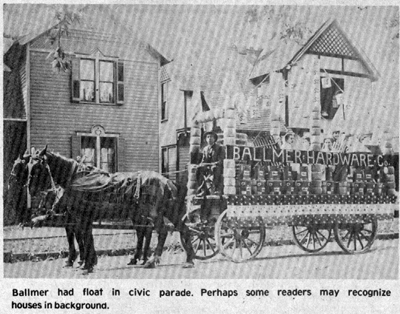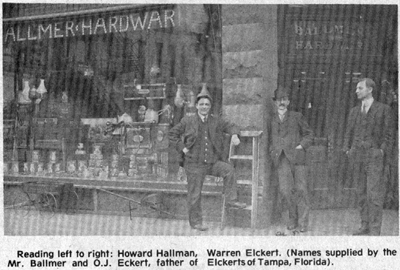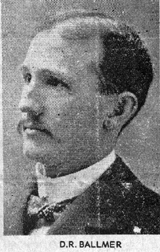July 17, 1980



Picture #1 – Ballmer had float in civic parade. Perhaps some readers may recognize houses in background.
Picture #2 – Reading left to right: Howard Hallman, Mr. Ballmer and O.J. Eckert, father of Warren Eckert (Names supplied by the Eckerts of Tampa FL)
Picture #3 – D.R. Ballmer
As soon as the RT papers reached readers June 24, I had a call from Robert McMeen, who informed me that I had omitted the name of one of the hardware stores that was included in the story about Fruth Hardware.
I had gone through old city directories at the library and I couldn’t imagine what store it was.
McMeen told me it was the Rothrack-Pifer Hardware, at 102 S. Main. As soon as he mentioned it, I knew I had missed it. It was not in the directories.
Another name which I was sure was included with the story was Ballmer Hardware, also at 102 S. Main at one time, but was evidently omitted.
The accompanying photos show Ballmer Hardware and D.R. Ballmer, the proprietor, as recorded on postcards loaned to me by Warren N. Eckert, Tampa Fl.
One of the postcards shows how Ballmer advertised his business by entering a horsedrawn wagon in a community parade. Apparently, Ballmer had a keen sense of humor when it came to advertising.
On the reverse side of the postcard showing his likeness was the following description: “On the other side is given a likeness of a notorious character still at large, and wanted for the MURDER of high prices on stoves and ranges, tinware, cooking utensils, tin and steel roofing, spouting, farm machinery, builders, and heavy hardware, glass, belting, B.P.S. paints and varnishes. He is said to have made the assault with an iron will, forged to a caststee; determination. Description – The accused is a slim, dark complexioned individual less than 17 hands high, weight less than 500, wears a 50 cent shirt with his shoes rundown at the heel, had black eyes and hair with a bald spot on top, big feet and a large appetite. When last seen, he was doing business at Big hardware Store in the Alcott Block, Fostoria. A Liberal Reward will be given to anyone who catches him asleep during business hours – D.R. Ballmer.
According to Hal Hoerig, proprietor of Fruth Hardware, the article about his store has brought many responses from readers and customers…even out of town.
KIEFFER’S STORE
Carl Cole, one of my Potluck readers is my watchdog he watches my column regularly and tells me if I make a mistake. Recently I placed Keiffer’s Racket Store next to the old Fostoria Hospital on South Main. He checked a directory and reminded me it was not next to it, but a little farther north.
In that same item, I mentioned that Robert Kieffer was the only one of the Frank Kieffer family still living. Mrs. Carl Clark, 229 E. Lytle, telephoned to inform me she was a daughter of Frank Kieffer and still living as was her other brother, Marion, 216 E. Lytle. Mrs. Clark jokingly remarked that as soon as she read the article she decided to call. I wasn’t going to let you bury the rest of the family yet.
Our conversation brought back many memories of Ken. He was a schoolmate of mine, class of 1923. I recall many comical incidents about him in school.
WATERWORKS TOWER
The Chamber of Commerce soon will publish a new brochure about Fostoria, and on the front cover there will be a picture of the base of the old water tower at Fostoria Water Works on West Fremont St. The original water tower was featured in a Potluck article Sept. 13, 1979, and that prompted its use in the new brochure. I contributed some descriptive copy for the new brochure.
BORQUIN STORY
Esther Shaffer wrote about that article.
Miss Bourquin loved a good laugh, and she certainly would have had one at the statement that she was an Irish Lass. Why Sproutie thought that I can’t imagine unless it was her quick temper, but the Irish aren’t the only ones with a short fuse. Actually, she was as French as Alphose and Gasten. Bourquin was originally from bougin, meaning an ancient book. Since the French “U” is pronounced like “yer” it quickly became Bourquin on this side of the Atlantic.
I like her simpler poetry better than the one you quoted. I think that one was tongue in cheek. She knew what opinion Saint Paul would have of the lesbians of Lesbos from Soappho on. He didn’t have a very high opinion of women in general if we are to judge by his writings. I like this one:
A SECRET SHE CAN KEEP
She never had a secret she could keep
Her mother always asked her and she told.
She even talked, when troubled, in her sleep,
For not a single thought could she withold.
She showed her husband every hidden hook
within her heart; as foolish women do
Her children read her like an open book,
Even her dearest memories they knew.
But now at last her lips are tightly sealed;
A smile upon them seems to come and go
In triumph for a story unrevealed
She has a secret that no one can know.
MCDOUGAL STREET
The McDougal Street article brought a telephone call from Lester Kisabeth. He was born and reared on a farm east of Fostoria not too far from the area where Barney McDougal settled. Kisabeth was related to the Rinebolds, named in that article. He attended the rural Punk Hollow school, before coming to Fostoria High School, and consequently is acquainted with that area east of town.
SAILING VESSEL THE FOSTORIA
About a year ago Lester Kisabeth gave me a lead on a prospective story. His son, Don, a doctor (O.D.), in Sandusky is also a history buff. Don came across an item in an old issue of the Daily Commercial Register, published in Sandusky in 1856, which had been reprinted from The Detroit Tribune: “New Vessels – Two new vessels have been built and recently launched at Black River, Ohio, which for their superior construction and fine model, are highly spoken of. The name given to one is The Fostoria, and she is intended chiefly for the timber trade, with a carrying capacity of 300 M feet. The Henry Chapman, which is the name of the other, is of a smaller class and will carry about 4,000 bushels of grain. Both were modeled and constructed by Scott Lyone, a shipwright of considerable fame at that point.
I attempted to pursue the item to see what further could be learned. I knew that C.W. Foster, the storekeeper in the early days of Fostoria, was also active in commercial ventures in the areas of Fremont, Sandusky, and Black River Ohio (now Lorain).
Very little was turned up in my research but since the vessel The Fostoria was chiefly for timber trade, and since there were vast amounts of fine native timber all through this area, undoubtedly C.W. Foster was active in the clearing of trees from the land and shipment of timber from Black River. For that reason the vessel was named after him. My conclusions coincide with those of Don Kisabeth.